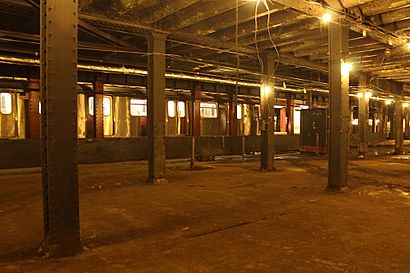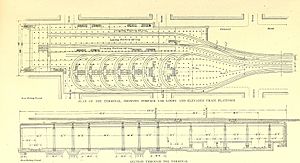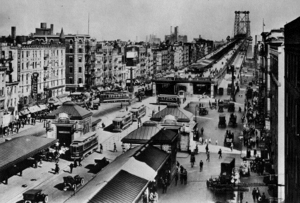Williamsburg Bridge Trolley Terminal facts for kids
Quick facts for kids
Williamsburg Bridge Trolley Terminal
|
||
|---|---|---|
| Streetcar terminal | ||

The now-closed trolley terminal in 2013.
|
||
| Location | Delancey Street & Essex Street New York, NY 10002 United States |
|
| Coordinates | 40°43′07″N 73°59′18″W / 40.71851°N 73.988199°W | |
| Owned by | City of New York | |
| Operated by | Brooklyn Rapid Transit Company (1908-1923) New York City Department of Plant and Structures (1923-1931) Brooklyn–Manhattan Transit Corporation (1931-1940) New York City Board of Transportation (1940-1948) |
|
| Platforms | 7 | |
| Tracks | 8 | |
| Construction | ||
| Structure type | Underground | |
| History | ||
| Opened | May 19, 1908 | |
| Closed | December 6, 1948 | |
| Services | ||
| None (abandoned)
|
||
The Williamsburg Bridge Trolley Terminal was a special underground station for trolleys (also called streetcars). It was located in the Lower East Side of Manhattan, right next to the Essex Street subway station. People used this terminal to ride trolleys from 1908 until 1948.
The terminal had special balloon loops. These loops allowed trolleys to turn around easily. After crossing the Williamsburg Bridge from Brooklyn, trolleys would use these loops to head back to Brooklyn. In 2011, there was an idea to turn this old terminal into an underground park called the Lowline.
Contents
What Did the Terminal Look Like?
Underground Station Design
The trolley terminal was built underground. It was located beneath the south side of Delancey Street. This area is between Clinton Street and Norfolk Street. It was also very close to the subway tracks that went towards Brooklyn.
The terminal had eight balloon loops. These loops were like big circles of track. They connected directly to the trolley tracks on the Williamsburg Bridge. This design made it easy for trolleys to cross the bridge, turn around, and go back to Brooklyn. The loops were numbered 1 to 8.
Between the loops were seven low island platforms. These platforms were slightly raised from the tracks. Each platform had wide staircases. These stairs led up to the street level. Each loop could hold two trolleys at a time. A trolley would stop at one end to let passengers off. Then it would move to the other end to pick up new passengers. The terminal had both electric lights and special openings. These openings allowed natural light to come in.
Here are the trolley lines that used each loop:
- Loop 1: Nostrand Avenue Line, Belt Line
- Loop 2: Broadway Line, Reid Avenue Line
- Loop 3: Wilson Avenue Line
- Loop 4: Ralph Avenue Line
- Loop 5: Bushwick Avenue Line
- Loop 6: Sumner Avenue Line, Tompkins Avenue Line
- Loop 7: Williamsburg Bridge Local
- Loop 8: Grand Street Line, Franklin Avenue Line
Street-Level Connections
There was also a terminal at street level. This part was for trolleys that traveled all the way through Manhattan. These trolleys came from companies like the New York Railways Company. They traveled along the north side of the bridge. They ended up at the Washington Plaza trolley terminal in Williamsburg, Brooklyn.
The covered stairs from the subway and underground terminal led directly to shelters. These shelters were for the Manhattan street-level trolleys. Both the stairs and shelters had special terracotta designs. The exit stairs were like small buildings called kiosks. They were made of concrete and decorated with blue and white tiles.
Trolley Line Transfers
Many Brooklyn trolley lines used the Williamsburg Bridge. They ended their journey at this terminal. Some of these lines included the Belt Line and the Broadway Line. Other lines were the Bushwick Avenue Line, Franklin Avenue Line, and Grand Street Line. The Marcy Avenue Line, Nostrand Avenue Line, Ralph Avenue Line, Sumner Avenue Line, Reid Avenue Line, Tompkins Avenue Line, and Wilson Avenue Line also used it.
Some of these lines, like the Franklin and Nostrand Lines, went all the way to Coney Island. The Marcy Avenue line went to a racetrack in Sheepshead Bay. The Wilson Avenue Line traveled to resorts in Canarsie. The Grand Street Line even went to an amusement area in northern Queens. This area is now where LaGuardia Airport is located.
History of the Terminal
Building the Terminal
The Williamsburg Bridge first opened on December 19, 1903. In 1904, it was decided that Brooklyn streetcars would cross the bridge. They would end their trip at Delancey Street in Manhattan. Manhattan trolleys would end their trip in Brooklyn.
On November 6, 1904, Brooklyn streetcars began crossing the bridge. In 1905, plans were made to build a permanent underground terminal. This terminal would be for Brooklyn streetcars. It would also connect to future elevated train lines. This station eventually became the first stop of the BMT Nassau Street Line.
The Essex Street trolley terminal was built along with the subway station next to it. There were some delays because the subway station plans changed. Both stations were built using a method called cut-and-cover. This meant digging up Delancey Street, building the tunnels, and then covering them back up. The tracks leading to the terminal were also lowered.
Before the terminal was finished, trolleys stopped on the street. This caused a lot of traffic and made it hard for passengers. The underground trolley terminal finally opened on May 19, 1908. New York City mayor George B. McClellan Jr. drove the first streetcar into the new terminal. This new terminal helped the trolley company carry twice as many passengers over the bridge.
Changes and Closure
On December 1, 1923, trolley service over the Williamsburg Bridge stopped. This was because there wasn't enough money being made. There was also a disagreement with the city about tolls. The trolleys then only went as far as Washington Plaza in Brooklyn. The city started its own shuttle service over the bridge.
On February 15, 1931, the trolleys started running to Manhattan again. This happened after the city's shuttle service ended. However, only a few lines, like the Nostrand and Ralph lines, crossed the bridge. The other lines still ended in Brooklyn.
On December 6, 1948, the last trolley line over the bridge stopped running. This was a shuttle service between the Manhattan and Brooklyn terminals. It was replaced by the B39 bus route. After this, the Essex Street terminal was closed. The small buildings (kiosks) that led to the terminal and subway station were removed from Delancey Street.
Images for kids






